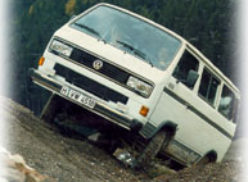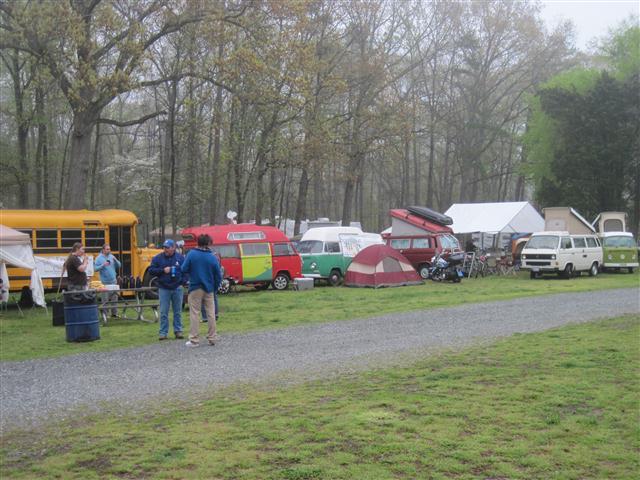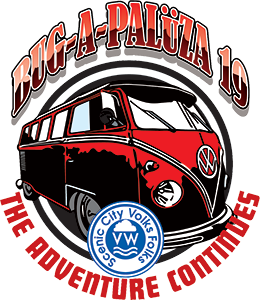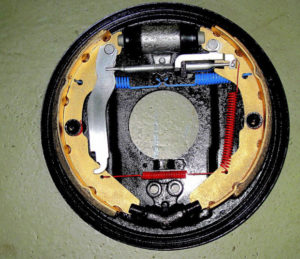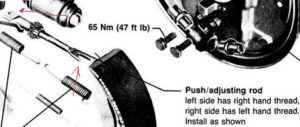By Bob Donalds
There are performance problems that have been traced to the hydraulic lifters that are in some air-cooled and all water boxer VW engines. Among the symptoms are noisy lifters on cold start. However keep in mind that if the van has been parked for a few days one or more lifters can bleed down and this can be the reason for the noise and does not necessarily mean that there are lifter problems. The symptoms of the lifter problems I am talking about in this article are low idle when cold, hard or not starting hot, poor performance when the engine warms up and the power (vacuum) assist brakes may not work as well at times because of the low intake manifold vacuum. These symptoms can be caused by improper hydraulic valve setup. This article is about how to properly setup the vanagon engine with hydraulic lifters. There have been a lot of differing opinions and methods regarding proper setup of hydraulic lifters.
This issue of proper setup has haunted me for years and cost me lots of time, money and peace of mind. In fact one of my own vans would not start hot unless it was push started or it was left to cool off for a couple of hours. This went on for 2 years with no trace of a reason until I understood that it was the lifters.
It’s no understatement when I say I have lots of trouble and limited success with preloading of the hydraulic lifters in the VW busses and Vanagons. In fact I have had lifters that would not take any preloading at all. It has been suggested that because the lifters are installed on their side that they trap air above the check ball that’s in the center of the lower piston that’s inside the hydraulic lifter and I agree. Air bound hydraulic lifters that are preloaded or that are set to O lash (no clearance or preload) do not allow the valves to close completely after the engine warms up. I believe this is due to the air in the lifter expanding as the engine warms up. I now understand that installing new or used lifters pre-loaded (no valve clearance) may NEVER allow the hydraulic lifters to displace the air remaining in the lifter because the plunger’s travel in the lifter body is minimized.
A long time ago I gave up trying to fill the lifters per Bentley and never looked at those pages again until I spoke with Stan at Bentley publishing who pointed out that there are two versions of the lifter bleeding process in the book (on page #15.7 and 15.24). I personally found both descriptions confusing. The first method instructs you to fill the lifter with oil and then install the lower piston using a scribe to bleed off the oil under the piston as you press the piston into place. As for installing the lifter socket into the lifter they don’t tell you that after you get the lower piston in place it travels back up when you let it go of it, leaving no room to install the lifter socket and clip. The second procedure would have you compress the lifter in a press with an old push rod and purge the air as the lifter is submerged in oil. They don’t say the procedure can take as long as ten minutes per lifter and that a hydraulic press is needed. So I, as most people do, put only enough oil in the lifter so I can compress it enough to get the clip installed.
In the Past
When trying to adjust the valves on a rebuilt engine, or when working on an engine that has had the heads or rockers off for a few days or when replacing lifters I have recommended the following. Set the valve lash to .006″ (i.e. no pre-load). This does two things: first the valves will for sure close all the way when the engine warms up, and, secondly, the piston in the lifter is now traveling it’s full range of movement has a much better chance of pumping out any remaining air. Run the engine for a couple of weeks before trying to preload the valves. Bring the engine up to running temp then let it cool down to the point that you will not burn yourself when you start to work on the engine. While the engine is still warm restart it for no more than 30 seconds and check for any valve noise. If you hear noise, drive the car for a few more days and check it again. Next, remove the valve covers, bring each piston to TDC, and turn the adjuster screws in ¼ to ½ turn. If the valve opens when you turn the adjusting screw in this means the lifter is fully pumped up with oil and you can tighten the lock nut. In most cases the lifters will now self-adjust and allow the valve to fully close and stay pumped up. If instead of the valve opening, the rocker arm moves the lifter as you turn the adjuster, then re-set it to .006ths clearance, reinstall the valve cover, and recheck it in a few days. The idea is to replace any unwanted air in the lifter with oil.
So what’s new?
In the past week I had a customer call and tell me he had not tightened the bolts on his torque plate – the ones that hold the plate to the converter – and after 1400 miles, and having no luck finding that rattling noise, the final bolt came loose, the engine seized, and the van stopped moving. I offered to help him repair the engine. When he dropped it off I got the rest of the story. It seems that after a highway run of less than an hour at 65 mph he pulled in his drive way and let the engine idle and the oil light came on. He also reported that he thought the engine was down on power. At this point I felt that I might learn something if I took the engine apart. So I offered to do so at no expense to the customer and he agreed.
The first thing I did was to put the engine on the engine stand and install a flywheel and put my cut up bell housing and starter motor on so I could spin the engine and test the oil pressure. The oil pressure was at the low end of the normal range 45pds with 10/30. The next test was the compression test and it was 125 on all cylinders a – little low but still ok. Next step was to look at the rockers and check to see if the customer had preloaded the valves. Some valves had lost clearance while others still had approximately .006ths. I was very surprised to see that some lifters were still soft and air bound because the customer had not reported any lifter noise. When the engine was disassembled I inspected and measured everything. The inspection revealed that the only damage or problem was that the customer had scuffed all four pistons on the load side (the load side of the piston is the side that is pressed against the cylinder wall as it’s pushed down on the power stroke).
I was a little disappointed not to have found more of a problem that would explain the oil light coming on (even though the customer had pushed the engine too fast when it was new). The customer had agreed to buy new pistons and cylinders. I thought that was the end of it with no great discoveries until my engine assembler, John Silva, pulled the lifters apart for inspection. John over filled one of the lifters and could not get the lower piston back down into place and instead of pulling the piston out and removing the oil he tried moving the check ball to one side with a scribe and pushed the piston down with a small screw driver. It dropped down enough to allow him to install the upper lifter socket and clip. The next step is what’s missing from the Bentley procedure. John took the same scribe that was used to release the check ball and installed it in the oiling hole on the side of the lifter body. This held the lower piston down so that he could install the upper socket and retaining clip. Once the clip was in place he tested the lifter by pushing the upper socket. The lifter was hard as a rock indicating that there was no air in the lifter. No other methods that I have tried had these results. This looked promising but I remained skeptical. I asked John to finish bleeding the rest of the lifters in the same way and adjust the rockers to the usual .006″ lash. We would test the compression as usual after the engine was completely assembled. The first compression test showed that we had 135 lbs on all cylinders. Next we preloaded the valves ½ turn and immediately repeated the compression test: some of the valves had not closed so we waited ten minutes and repeated the test. The compression was slightly lower: 125 lbs on all cylinders. Because it was lower we then tested each intake and exhaust port with a vacuum tester to see if the valves were closed and found that all the valves were sealed 100 percent. We next removed the valve cover and checked each lifter by prying on the rocker and looking for movement: all the lifters were still hard as a rock. The next morning we checked for soft lifters and found that the # 2 exhaust valve lifter was soft. We spun the engine again for about one minute using the starter motor and then checked the #2 lifter: it had regained most of its rigidity.
My conclusions
Lifters can be pre-bled and preloaded at ¼ to ½ turn at the time the engine is being assembled provided that the above-mentioned procedure is followed. However, assembled engines always have at least one or more lifters on the lobe of the camshaft holding them open. Open valves have their springs compressed thereby increasing pressure on their lifters. The increased pressure will cause the lifters to lose oil over time. This can be days or weeks, depending on how clean the oil and the lifter’s check valves are. These engines may not have enough oil available to the expanding lifters when the engine is first turned over during the start up procedure. If the oil galley is empty, the lifter can take in air instead of oil and becomes air-bound. An air-bound lifter may expand as the engine heats up, and thereby prevent a valve from closing. To prevent this, some shops use a pre-oiler. Oil is pressure-fed into the oil galleys before the engine is first started.
So, caution must be used when preloading valves on any new engines. Air-bound lifters are hard to detect. Exhaust valves that don’t close completely when the engine warms up will not transfer their heat to the valve seat, as it was designed to. Instead, this excess heat travels down the valve stem and scorches the oil lubricating the valve stem and guides, drastically reducing their life. I have seen this specific damage time and time again on air-cooled engines as little as 10 K miles.
I consider pre-loading valves to be optional. You may never have had this lifter problem before, but I assure you the potential is high and expensive. While the intake manifold vacuum is an easy way to know if the intake valves are completely closed, the only way to be 100% sure all the valves are closed when the engine is warmed up is to do a cylinder pressure differential test (sometimes known as a “leak down” test) that is commonly done on race engines and aircraft. This test measures air pressure going into a cylinder, and how much air remains. 2%-4% is ideal.
I hope this helps
